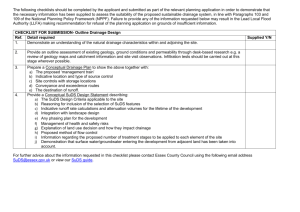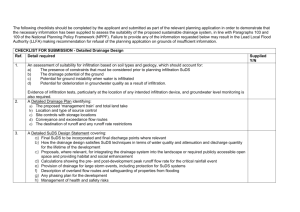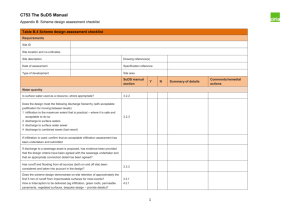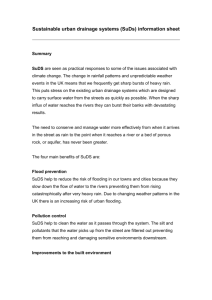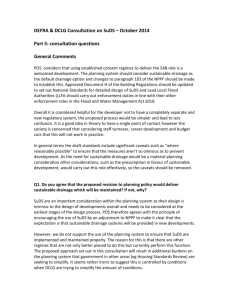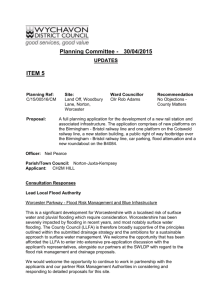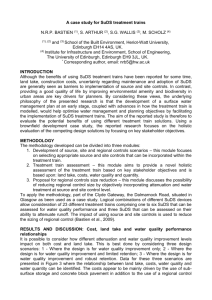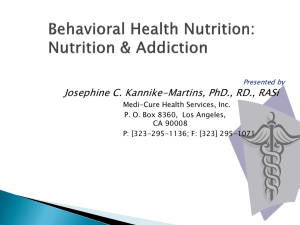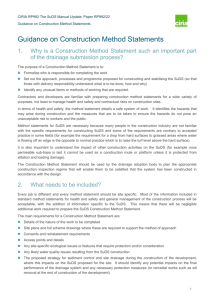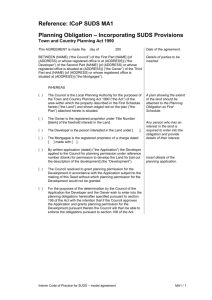Interim Policy Statement on Sustainable Drainage Systems
advertisement
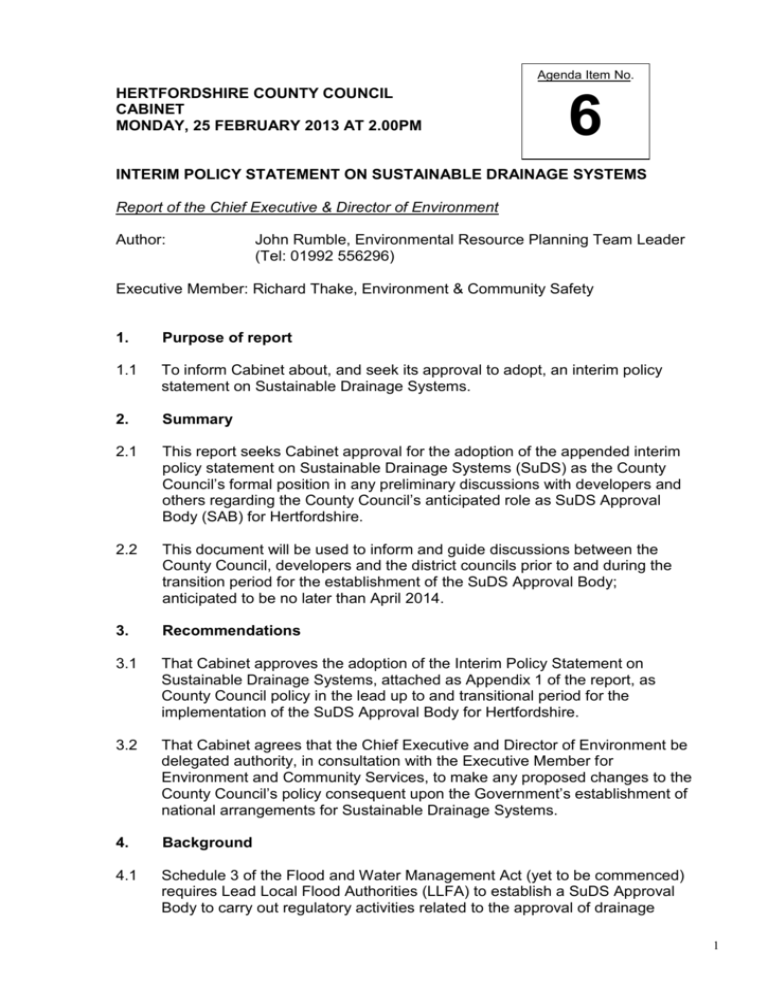
Agenda Item No. HERTFORDSHIRE COUNTY COUNCIL CABINET MONDAY, 25 FEBRUARY 2013 AT 2.00PM 6 INTERIM POLICY STATEMENT ON SUSTAINABLE DRAINAGE SYSTEMS Report of the Chief Executive & Director of Environment Author: John Rumble, Environmental Resource Planning Team Leader (Tel: 01992 556296) Executive Member: Richard Thake, Environment & Community Safety 1. Purpose of report 1.1 To inform Cabinet about, and seek its approval to adopt, an interim policy statement on Sustainable Drainage Systems. 2. Summary 2.1 This report seeks Cabinet approval for the adoption of the appended interim policy statement on Sustainable Drainage Systems (SuDS) as the County Council’s formal position in any preliminary discussions with developers and others regarding the County Council’s anticipated role as SuDS Approval Body (SAB) for Hertfordshire. 2.2 This document will be used to inform and guide discussions between the County Council, developers and the district councils prior to and during the transition period for the establishment of the SuDS Approval Body; anticipated to be no later than April 2014. 3. Recommendations 3.1 That Cabinet approves the adoption of the Interim Policy Statement on Sustainable Drainage Systems, attached as Appendix 1 of the report, as County Council policy in the lead up to and transitional period for the implementation of the SuDS Approval Body for Hertfordshire. 3.2 That Cabinet agrees that the Chief Executive and Director of Environment be delegated authority, in consultation with the Executive Member for Environment and Community Services, to make any proposed changes to the County Council’s policy consequent upon the Government’s establishment of national arrangements for Sustainable Drainage Systems. 4. Background 4.1 Schedule 3 of the Flood and Water Management Act (yet to be commenced) requires Lead Local Flood Authorities (LLFA) to establish a SuDS Approval Body to carry out regulatory activities related to the approval of drainage 1 consent for development. For Hertfordshire, the County Council is the LLFA and as such will be required to establish a SAB once commencement of this section of the act takes place. 4.2 As part of the preparations for this new regulatory responsibility the Environment, Economy and Community Safety Cabinet Panel, at its meeting on the 6 November 2012, was asked to consider an Interim SuDS Policy Statement. This policy statement sets out the Authority’s position in the lead up to and transitional period for the commencement of this part of the Flood and Water Management Act (F&WM Act) 2010. Following consideration at the Cabinet Panel meeting, the Panel agreed to recommend the Interim SuDS policy Statement to Cabinet for adoption by the County Council. 4.3 Recent discussions with Defra (the national government department with responsibility for the implementation of SuDS) have indicated that these new regulations are expected to commence in April 2014. 5. Content of the interim policy statement on SuDS 5.1 The interim policy statement sets out a total of nineteen ‘requirements’ for SuDS schemes that the County Council in its new role as the SAB for Hertfordshire will be asking developers to comply with.. The following is a brief summary of these requirements: 5.3 Requirement 1 says that for a SuDS to be adopted it must comply with current local and national standards and guidance. Requirement‘s 2 to 4 explain how information will be required from developers as their projects progress or become more complex. Requirement 5 sets out that SuDS must be seen to comply with local planning policy and guidance where that is in place. Depending on how the Government responds to the consultation on the National Standards the SAB will be able to give this requirement more or less weight. But it is a clear statement of the County Council’s desire for a joined-up approach with district & borough council partners. Requirement‘s 6 to 11 cover the main SuDS design policies. Requirement 12 explains the approval stages. Requirement 13 covers additional general design requirements, where enabled by local plan policy, again in the interests of a joined-up approach. Requirement‘s 14 to19 are specific detailed technical requirements for the design, construction, adoption and maintenance phases. The wording of these requirements is mostly to establish them as ‘must do’s’ rather than ‘should do’s’. This is because of the substantial potential of longterm and possibly unfunded liabilities falling to the County Council as a result of the primary legislation, requiring that a precautionary approach be taken. Currently the guidance and legislation indicates that, as the SAB, the County Council will have to adopt new SuDS schemes and be responsible for their on-going maintenance and repair. It is still unclear if this will actually be the case but it is prudent to plan for this eventuality. 2 6. Applying and reviewing the guidance 6.1 The intention is to implement the interim policy statement and the associated guidance as far as is reasonable and review its application within a year, or earlier, if there are significant changes in the national context. 7. Financial implications 7.1 There are no additional financial implications arising from this report. 7.2 For 2012/13 additional funding of £50k has been provided as a one-off item to assist in the development and implementation of the SAB function within the County Council. Because of the delay in central government commencement of these new responsibilities a request has been made to put this funding into a reserve to be used in the financial year 2013/14. 7.3 The full and ongoing costs associated with implementation of the SAB are expected to be met from application fees charged to developers for drainage consent. Although full implementation has been delayed (it was anticipated to be from October 2012) the current expectation is that the County council will take on these new duties from April 2014. 7.4 The mechanism by which the costs of ongoing maintenance of SuDS features following adoption by the SAB have yet to be finalised. These are the subject of discussion between Defra and relevant stakeholders, including Lead Local Flood Authorities, with a consultation expected later in 2013. Any proposals will be scrutinised by the Chief Executive and Director of Environment in consultation with the Economy and Community Safety Cabinet Panel and an appropriate response returned. 8. Equalities Implications 8.1 There are no equalities implications arising from this report. Background Information Report and minutes, Environment, Economy & Community Safety Cabinet Panel, 6 November 2012 3
